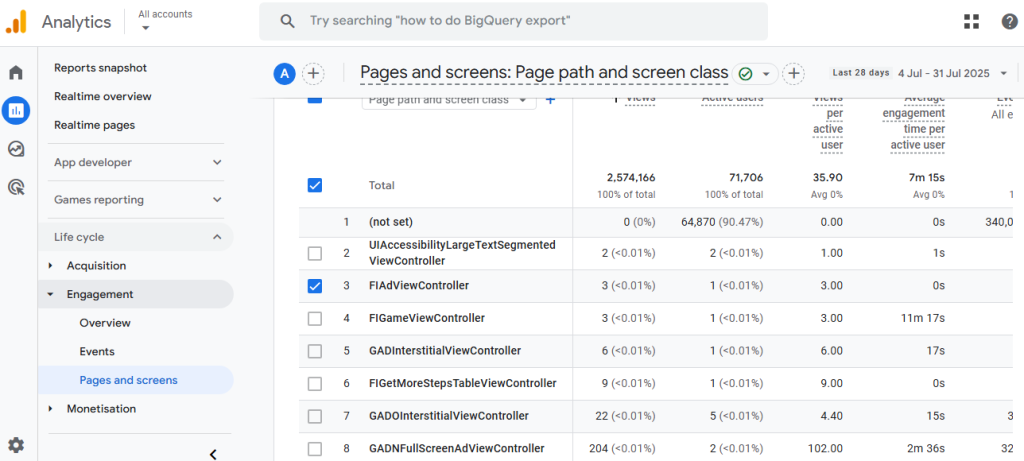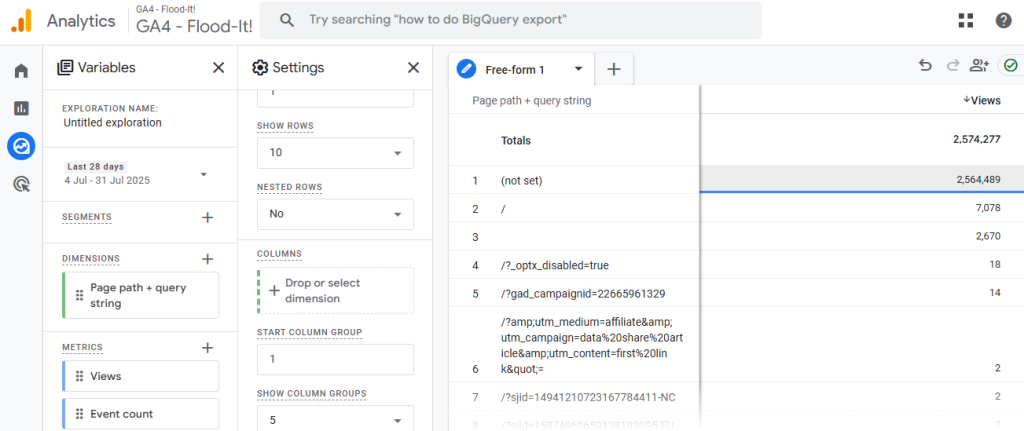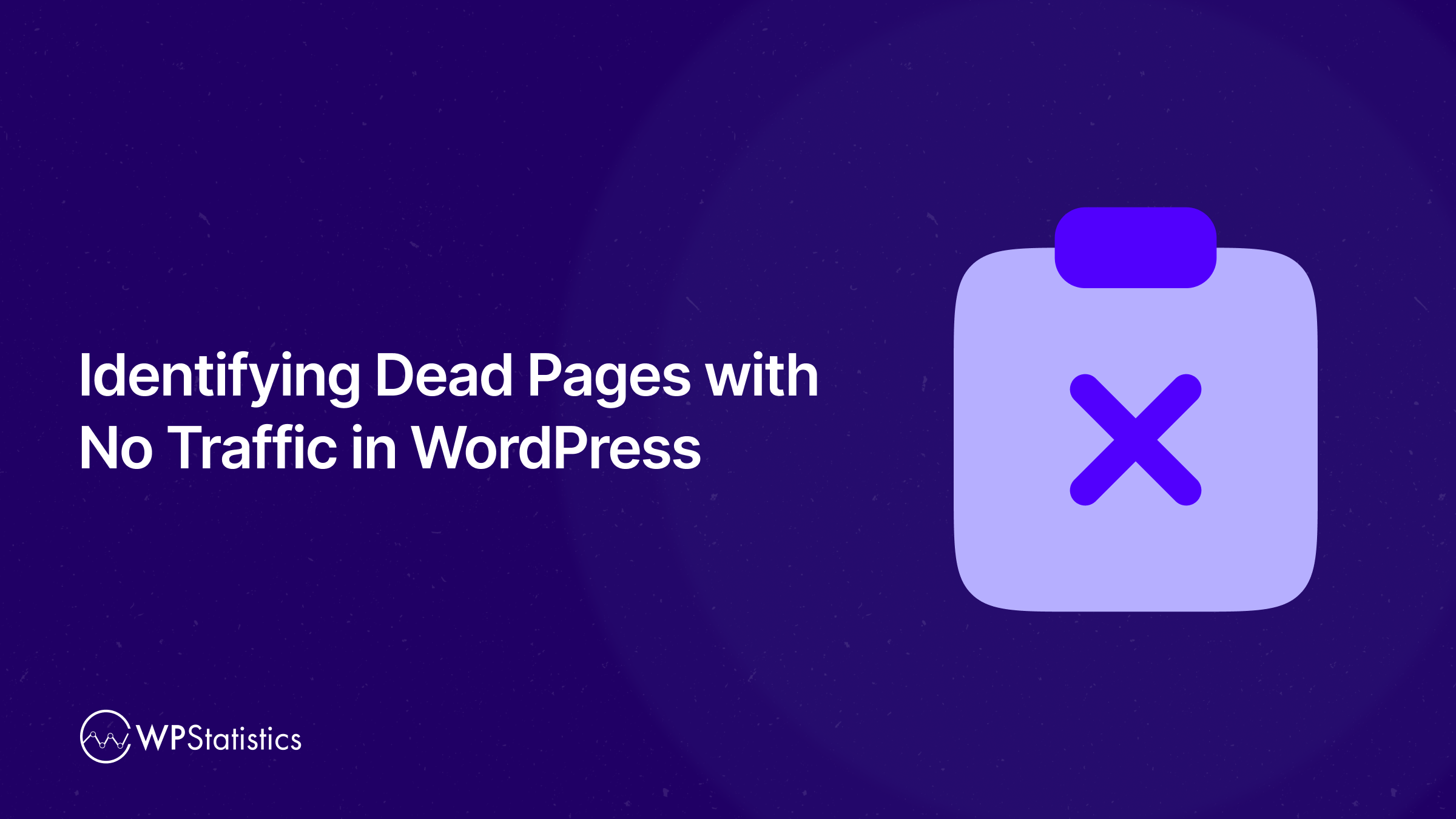Learn how to identify dead pages in WordPress to optimize your website.
Ranking well on Google requires consistent content auditing and optimization. If you create and publish content without tracking the performance and auditing, you’ll lose the chance of ranking on the first page of SERPs.
Content auditing is a critical part of your website SEO strategy. It helps you recognize the weaknesses and strengths of your website and improve its performance accordingly.
One of the most important tasks in website auditing is identifying dead pages and optimizing or removing them to improve the overall performance of your website.
In this blog post, we’ll explain how you can use tools like WP Statistics and GA4 to recognize dead pages and optimize your site.
What Are Dead Pages?
Dead pages are URLs on your website with little or no traffic. Many types of pages can act like this, including:
- Product pages: If you have a product page that describes a product/service that is no longer available.
- Blog posts: When you publish a blog post about a topic that is now outdated and no longer relevant, the page is considered dead.
- Pages with broken links or missing content.
- Pages with a high bounce rate that users leave quickly without engaging.
These pages will impact your site’s SEO performance and your website’s authority on the topic.
Moreover, it will significantly hurt user experience because when users see empty or outdated pages, they consider your site a waste of time!
So, identifying dead pages in WordPress and updating or removing them is a critical task in website auditing.
Stay with us to learn how to find dead pages in WordPress and audit your website.
Best Tools to Identify Dead Pages in WordPress
First, let’s review the best tools to identify dead pages in WordPress. The following table compares the 5 top tools that help you find dead pages and audit your site:
| Tool | Type | Key Features | Best For |
|---|---|---|---|
| WP Statistics | WP Plugin | Local traffic tracking, simple reports | Beginners, privacy-focused users |
| Google Analytics 4 | Analytics Platform | Full user tracking, custom reports | Advanced users, marketers |
| Google Search Console | Webmaster Tool | Index, crawl, and error reports | SEO audits, indexing checks |
| MonsterInsights | WP Plugin | GA4 data in the dashboard, user-friendly | Non-tech WordPress users |
| ExactMetrics | WP Plugin | GA integration, real-time stats | Bloggers and site owners wanting quick stats |
You need to choose your tool according to your requirements. WP Statistics is a free WordPress plugin that lets you track all the necessary website metrics on your dashboard without needing any third-party tools.
Google Analytics is also the most famous web analytics tool that allows users to track their website’s performance in real time.
Now, it’s time to learn how to identify dead pages using these tools.
How to Find No-traffic Pages with WP Statistics?
WP Statistics is a powerful WordPress plugin that gives you visitor data directly within your WordPress dashboard—no need for third-party tools or complicated integrations.
It’s especially useful for identifying no-traffic or low-traffic pages quickly and taking action on them.
Below is a step-by-step guide to using WP Statistics to locate dead pages on your site:
Step 1: Install and Configure WP Statistics

Installing WP Statistics is really straightforward. You just need to go to your WordPress dashboard and find the Plugins item in the left-hand menu. Then, click “Add Plugin”.
Now, you can see a search bar. Type “WP Statistics” and find the plugin. After that, click “Install Now” and then “Activate”.
Installation is now complete, but you need to configure the plugin according to your requirements.
To do that, go to Statistics → Settings → General. Now, enable Visitor IP collection and Page tracking, and exclude bots and admin data for cleaner data.
You can also set some optional configurations, like a 90-day or 180-day data retention policy. WP Statistics offers GeoIP tracking if you want location-based insights.
Step 2: View Traffic by Page

Now that you’ve installed and activated WP Statistics on your WordPress website, you need to give it some time, like a few days or weeks.
It will collect information from your site’s visitors and traffic during that period. To analyze traffic, you must go to Statistics → Page Insights → Top Pages.
Then, use the dropdown to filter the results by time range, like last 30 days or custom. Now, WP Statistics will display a table showing each page on your site and how many views it received during the selected period.
Now, you can find dead pages with near-zero views during the selected timeframe. Also, you can include pages with fewer than 5 views as low-performing pages.
Step 3: Export Pages Data

If you have a large site, you’d better export this data for better filtering. Here is how:
- Go to the Optimization menu
- Click the Data Export button
- Choose “pages” under the Select Data Source menu
- Choose CSV under the Choose Export Format menu
- Open the file in Excel or Google Sheets.
- Sort the results by the count
- Highlight pages with zero or near-zero views

Now, you have a list of dead pages on your website.
Step 4: Analyze Each Dead Page
It’s time to analyze each page to be able to decide whether it needs optimization or should be deleted.
The following table is a simple guide on how to decide about dead pages:
| Question | Action if YES | Action if NO |
| Is the content outdated? | Update content | Move to the next check |
| Was it ever promoted/shared? | Improve visibility | Consider merging or redirecting |
| Does it target relevant keywords? | Refresh & optimize | Merge or remove |
| Does it have internal/external links? | Keep or redirect | Safe to delete or noindex |
| Is it functionally or legally important? | Keep & noindex | Remove or redirect |
But finding dead pages is just half the story!
Once you know which pages need attention, the next challenge is making sure your updates actually bring back traffic and engagement.
This is where the WP Statistics Marketing Add-on shines. It helps you track marketing campaigns, UTM parameters, and source channels so you can measure if your revived content really performs, and which promotion strategies actually work.
How to Use Google Analytics’ Dead Page Report?
First of all, you should know that there is no built-in dead page report on Google Analytics. So, you must create a custom report to identify dead pages on your WordPress website.
Here is how:
Step 1: Use the Built-in “Pages and Screens” Report
There was an old report on the previous versions of Google Analytics, called “All Pages”. You can find its equivalent on GA4 here:

Reports → Engagement → Pages and Screens
You need to use it to have a customized dead page report. To do that, you have to sort the result by page title or page path. As you see, the default view will show pages ranked by number of views.
You can sort it so that you can see low-traffic pages at the top. Then, try to adjust the date range to see the results in the last 90 or 180 days. Remember that some pages may not get daily visits, so short date ranges might be wrong.
Search for pages with 0–1 views, because GA4 doesn’t display pages with literally zero events.
So, this method shows low-traffic pages, not entirely unvisited ones, but it’s great for a quick scan of weak-performing content on your website.
Step 2: Create a Custom Exploration

For deeper analysis, you can customize your explorations on GA4. You can build a report to identify pages with no or extremely low traffic.
You can follow the process below:

- Go to Explore → Blank Exploration
- Add Dimensions: Page path + query string
- Add Metrics like Event count, Views, and Users
- Drag to Table Rows/Columns
- Apply Filters like Event count = 0
- Set Date Range like 3–6 months to cover long-tail content

Remember that a page with zero events won’t appear at all in most standard reports. So, this exploration is crucial for your dead page report. It lets you manually build a report that includes these hidden pages.
Best Practices of SEO Audit for Dead Pages
Now that you have learned how to recognize dead pages on your site, it’s good to know how to remove this problem.
Here are some SEO tips for auditing your website in terms of dead pages:
1. Refresh and Update Old Blog Content
If the dead page is an old blog post, you must check if the topic is still relevant and interesting to your audience. Here are the best practices for improving your blog posts:
- Update outdated information, like statistics, links, tools, etc.
- Add new value to your blog posts, like examples, images, videos, or related insights.
- Improve readability with headings, short paragraphs, and internal links.
- Mention the date you updated the content to display its freshness.
Remember that Google prefers updated content, so updated posts usually regain lost traffic.
2. Merge Similar Pages
Sometimes you will publish multiple pages that cover similar topics. This usually happens when you forget you have previously published a similar topic a long time ago. When you publish several blog posts for a single topic, each page gets little or no traffic. This is sometimes called Keyword Cannibalization.
So, it’s essential to merge these blog posts into a single, stronger page. Try to use 301 redirects from the removed pages to the consolidated one.
3. Remove or Redirect Obsolete Pages
Sometimes you write a page about a specific topic or product, but after a while, the page no longer serves a purpose.
For example, the product or the offer expires. So, you have to delete the page if the content is truly obsolete and has no backlinks or SEO value.
If you think the page might have a bit of traffic, you can use a 301 redirect to guide users to a relevant alternative or parent category.
Remember that Google considers a crawl budget for your website. So, if you keep those useless pages, your budget will be wasted on them without getting traffic.
4. Noindex Low-Value Pages
Sometimes you have pages with no traffic that are essential for functionality. For example, admin dashboards, internal searches, or customer thank-you pages. You can’t remove them, but you also can’t allow them to appear in search results.
So, what to do?
You can add the noindex meta tag to the page’s head section. It’s good to use plugins like Yoast SEO or RankMath to easily manage noindex status. Google also lets you disallow crawling in robots.txt for URLs you want completely hidden from bots.
This way, you’ll remove these pages from Google’s index to focus ranking signals on the content you want.
5. Fix or Remove Broken Internal Links
When you remove or audit dead pages, you must check whether any other pages of your website are linking to these dead pages.
You can use tools like Broken Link Checker, Ahrefs, or Semrush Site Audit to find broken links. You can then remove them or update them to another relevant page.
6. Monitor Performance After Cleanup
Removing the dead pages or updating them isn’t enough. You must monitor the performance of your website to make sure you’re doing well.
The best web analytics tool to do that is Google Search Console. It allows you to check crawl errors and changes in indexing.
You can also track traffic shifts using Google Analytics or plugins like WP Statistics. Moreover, you can re-crawl your site using tools like Screaming Frog to verify redirects and indexing changes.
You must continue this auditing process regularly to make sure your website is healthy and is working efficiently.
Conclusion
Dead pages on your site can impact its SEO performance and waste the Google crawling budget for your domain. That’s why you need to have a regular auditing plan for dead pages. First, you need to use tools like WP Statistics and Google Analytics to identify pages with no or near-zero traffic. Then, you can decide whether the page is worth updating or should be deleted permanently.
FAQs
What should you do if you have pages that never get traffic?
You must regularly audit your site. Try to update useful pages to improve their traffic. Also, merge similar pages to avoid keyword cannibalization. You have to delete irrelevant ones or noindex them.
Why does 96.55% of content get no traffic from Google?
Most content doesn’t target relevant keywords, lacks backlinks, or fails to satisfy user intent. As a result, the pages remain invisible in search results. By detecting unused WordPress content, you can audit it and improve your site’s visibility.
How long does it take to rank #1 on Google?
You need strong SEO, relevant backlinks, and a great user experience on your site. It can take 3–6 months, depending on your site’s authority.
How do I increase my Google traffic?
Focus on keyword research, publish helpful content, build backlinks, improve site speed, and perform regular SEO audits.

